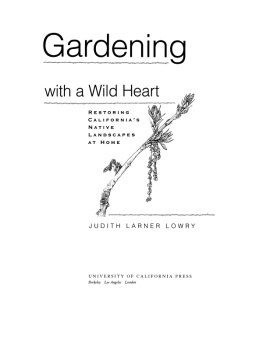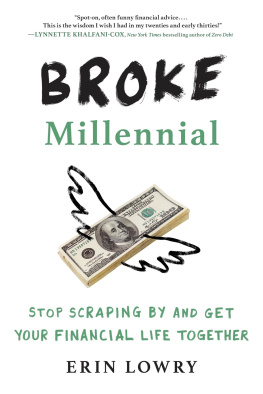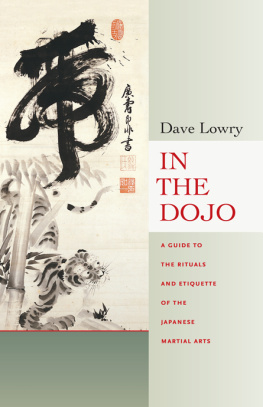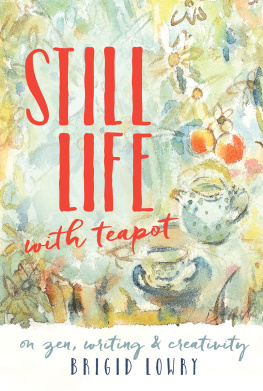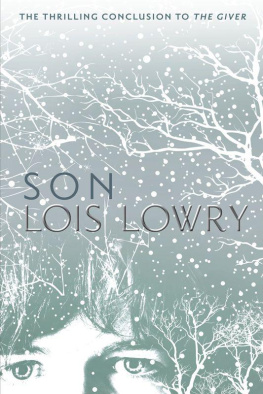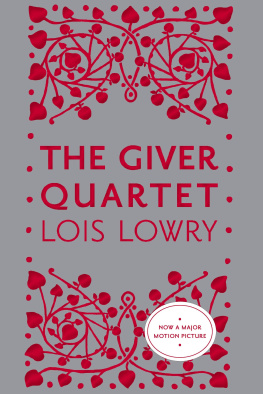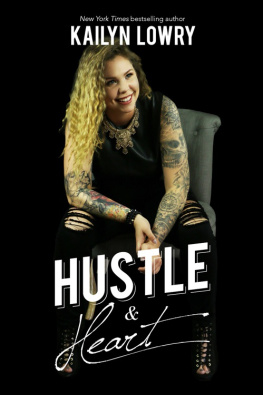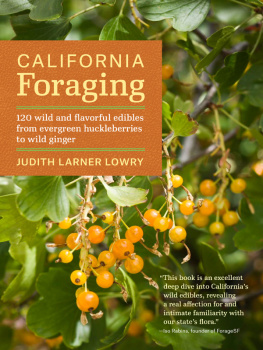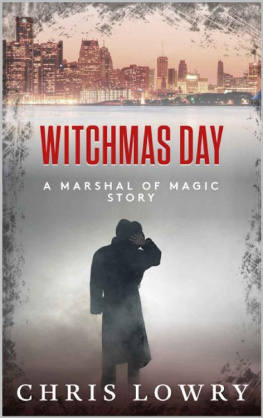Lowry - Gardening with a wild heart: restoring Californias native landscapes at home
Here you can read online Lowry - Gardening with a wild heart: restoring Californias native landscapes at home full text of the book (entire story) in english for free. Download pdf and epub, get meaning, cover and reviews about this ebook. City: Berkeley;California, year: 2007, publisher: University of California Press, genre: Romance novel. Description of the work, (preface) as well as reviews are available. Best literature library LitArk.com created for fans of good reading and offers a wide selection of genres:
Romance novel
Science fiction
Adventure
Detective
Science
History
Home and family
Prose
Art
Politics
Computer
Non-fiction
Religion
Business
Children
Humor
Choose a favorite category and find really read worthwhile books. Enjoy immersion in the world of imagination, feel the emotions of the characters or learn something new for yourself, make an fascinating discovery.
- Book:Gardening with a wild heart: restoring Californias native landscapes at home
- Author:
- Publisher:University of California Press
- Genre:
- Year:2007
- City:Berkeley;California
- Rating:4 / 5
- Favourites:Add to favourites
- Your mark:
- 80
- 1
- 2
- 3
- 4
- 5
Gardening with a wild heart: restoring Californias native landscapes at home: summary, description and annotation
We offer to read an annotation, description, summary or preface (depends on what the author of the book "Gardening with a wild heart: restoring Californias native landscapes at home" wrote himself). If you haven't found the necessary information about the book — write in the comments, we will try to find it.
Gardening with a wild heart: restoring Californias native landscapes at home — read online for free the complete book (whole text) full work
Below is the text of the book, divided by pages. System saving the place of the last page read, allows you to conveniently read the book "Gardening with a wild heart: restoring Californias native landscapes at home" online for free, without having to search again every time where you left off. Put a bookmark, and you can go to the page where you finished reading at any time.
Font size:
Interval:
Bookmark:

University of California Press
Berkeley and Los Angeles, California
University of California Press, Ltd.
London, England
1999 by
Judith Larner Lowry
Second paperback printing 2007
Botanical drawings Ane Carla Rovetta. Title page: male flower of blue oak. : soaproot bulb, with soaproot brush and mortar.
epigraphs: Rich Stallcup is quoted from Fire in Birdland, Point Reyes Observatory Quarterly Journal, Fall 1995; used by permission. Paul Shepard is quoted from Man in the Landscape: A Historic View of the Esthetics of Nature, 1967 by Paul Shepard; used by permission of Alfred A. Knopf, Inc.
Library of Congress Cataloging-in-Publication Data will be found at the back of this book.
Printed in the United States of America
13 12 11 10 09 08 07
12 11 10 9 8 7 6 5 4 3 2 1
The paper used in this publication meets the minimum requirements of
ANSI/NISO Z39.48-1992 (R 1997) (Permanence of Paper). 
Earth, be glad to see me.
KARUK TOBACCO PRAYER
PREFACE
When I started my mail-order seed business specializing in California native plants, I thought I would spend my days on sunny hillsides and within shadowed canyons, gathering jewel-like seeds of all shapes and colors. I thought I would be largely involved with seed cleaners and drying racks, with packets, scales, and catalogs. Yet it has turned out quite differently. Much of my time for the past twenty years has been spent in conversation.
More or less willingly, I have been a participant in countless conversations about many aspects of native plants. On the way, I have become fascinated by the assumptions, both implicit and stated, that govern gardening choices. I have gotten a sense of what people wanted to know, what I needed to learn, and where it all might lead. The activity of gardening with locally native plants has become a vehicle for ranging freely over the rich territories of land use history, local ecology, and land management.
I've tried to put it all together here, a long, lingering look at many aspects of this kind of gardening, from specifics on techniques of wildflower sowing to musings on the subtle effects of restoration gardening on a town. From a personal essay on wildland seed gathering to information on the linkages between voles and grasslands. While answering frequently asked questions of a practical nature, I seek at the same time to enliven the personal sense of living in a specific place with a complicated human, literary, and natural history.
The more I work with clients, the clearer it becomes that gardening as a restorationist has much to offer in strengthening newly established human roots and in deepening those ties to the land we inhabit that have been a given in human life for centuries. By seeing your particular piece of land as part of a larger plant-animal community and seeking to enhance old and established relationships through your style of gardening, you join that community.
Along the way, we find ourselves living in gardens of pleasure and hope.
ACKNOWLEDGMENTS
Acknowledgments and grateful thanks:
To my sister, Marjorie Larner, for discerning and encouraging manuscript review, and for a lifetime of sweet sisterhood.
To my brother, Bernard Larner, for his unique humor, sound advice, and staunch brothering.
To my father, Irvin Larner, for parenting of a superlative order, who helps me to persist in an inordinate number of ways.
For the texture of my days, thanks to Anna Harrington, Helen Londe, Ann Young, Judy and Phil Buchanan, Nancy MacDonald, Lea Earnheart, John O'Connor, Joanne Kyger, Mary Nisbet, Lynn Murray, Chris Weingarth, Kurtis Alexander, Meghan O'Hare, and Cabin Three, Christine Lisetti, the One? Three J Writing Group, Leslie Creed and Lloyd Kahn of Shelter Publications, Barbara Deutsch, Georgia Carmichael Connon, MegSimonds and Mark Butler, Kathleen O'Neill, Bob Levitt, and StuArt, for always asking.
To Dave Fross, for the saving grace of a seamless friendship and professional association, both essential. To Freeman House, for the inspiration of his work and his writing. To Jeffrey Creque, for prairie talk of the highest quality. To Craig Dremann, a fortuitous connection, replete with steadying good counsel
To my helpful agent, Andree Abecassis. To my excellent and painstaking editors at University of California Press, Doris Kretschmer, Dore Brown, and Peter Dreyer.
To Peter G. Smith, for years of all kinds of help, including a saintly patience in electronic matters. But mostly, for all that we have seen together.
To my daughter, Tarin Molly Patterson, cross-country girl, whose blithe and beautiful spirit has lighted and lightened my days these seventeen years.
To the memory of my mother, Sara Larner, who loved words, and of Gerda Isenberg, for the opportunity and the example.
And to my town. Home.
PART I
Beginnings

CHAPTER ONE  Gardening at the Seam
Gardening at the Seam
I wish so to live ever as to derive my satisfactions and inspirations from the commonest events, everyday phenomena, so that what my senses hourly perceive, my daily walk, the conversation of my neighbors, may inspire me, and I may dream of no heaven but that which lies about me. Henry Thoreau
Biodiversity has recently become a fashionable concept to promote, but should we try to enhance biodiversity just at the state and federal level and not at the county level or even in our back yards? Should we settle for small populations of species in distant parts of our state and nation, when with protection viable populations could exist as well in our own neighborhoods?
W. David Shuford, 1993
It's not as if they learned about willows and grasses in order to make baskets, but as if they learned to make baskets by knowing willows. Mary Austin, 1912
Discovering Home
Moving fifteen years ago to a small town on the north central coast of California, I was entranced by the miles of protected land that surrounded us. My first walks into those public preserves revealed to my grateful eyes the beauty and variety of coastal plant associations.
All shades of green and gray made a rich foliar tapestry, accented in spring and summer with the rainbow colors of coastal wildflowers. Rounded forms of shrubs and trees cast beautiful shadows on soft coastal hills. Where water seeped through cliffs, willows threaded surprising ribbons through the seemingly dry slopes. Light dappled the shade-loving ferns and flowers of dim canyons. I couldn't look enough.
Yet when I visited the gardens of my town, these local plants were conspicuous by their absence, as was any conversation about them. I came to see that I lived in a uniquely protected location that reflected little of its surrounding plant communities. My rambles revealed a slow but inexorable lessening of these native plant riches, a blanking out of natural values, beginning in gardens and towns and spreading into adjacent public lands. Observing small losses adding inexorably up, part of what Paul Ehrlich callsthe nickel-and-diming to death of our environment, I began a gardening, walking, and thinking investigation.
Walking and looking, I came to hypothesize that the group of native bluff and coastal scrub plants that hold these cliffs, hills, and valleys have just the right characteristics for the job. Their leaves filter rain to the soil in just the right way, their roots dig into the cliffs in just the right way, and the habitat structure they provide enables the greatest number of fauna of all kinds to thrive. I began to explore the ways, both obvious and subtle, in which we could benefit from the incorporation of the wild into our gardens.
Font size:
Interval:
Bookmark:
Similar books «Gardening with a wild heart: restoring Californias native landscapes at home»
Look at similar books to Gardening with a wild heart: restoring Californias native landscapes at home. We have selected literature similar in name and meaning in the hope of providing readers with more options to find new, interesting, not yet read works.
Discussion, reviews of the book Gardening with a wild heart: restoring Californias native landscapes at home and just readers' own opinions. Leave your comments, write what you think about the work, its meaning or the main characters. Specify what exactly you liked and what you didn't like, and why you think so.

